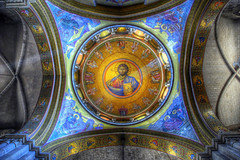 |
| The Church of the Holy Sepulchre, Old City of Jerusalem |
The Church of the Holy Sepulchre, known as the
Church of the Resurrection (
Anastasis) to
Eastern Orthodox Christians, is a church in the
Old City of Jerusalem that is
the holiest Christian site in the world. The Roman Emperor Hadrian erected a large platform of earth over the whole area for the construction of a
temple to Venus. A statue of Jupiter was on the site for 180 years (140-320 A.D.), when
Constantine converted the empire to
Christianity, he had the pagan temples dismantled, the earth removed and a
Church built over the spot. Originally built by the mother of
Emperor Constantine in 330 A.D., the Church of the
Holy Sepulcher is believed to be constructed on the hill of
crucifixion and the Church also includes the
Empty Tomb where the
Jesus Christ was buried (
The Christ rose from the dead after three days). The
original Byzantine church was destroyed by the
Persians in 614 A.D. Rebuilt shortly thereafter, the
Egyptian Caliph Al-Hakim destroyed the Church in 1009 and had the
Empty Tombdemolished to bedrock.
 |
| Ceiling of the Church of the Holy Sepulchre (Photo credit: slack12) |
The Crusaders rebuilt
the church and much of what is standing today is from that time
period. Inside the church is a rocky outcropping which is the
traditional place where the cross was placed.
Archaeological excavations
have demonstrated that this site was outside the city but close to one
of its gates and thus would have been a good location for a
crucifixion. Other
first-century tombs are still preserved inside the Church. "
Tomb of Joseph of Arimathea" and other burial shafts (kokhim) are clearly from the time of
Christ's death and attest to some kind of burial ground in the area. The
eyewitness historian Eusebius claimed that in the course of the excavations, the original memorial was discovered. However, he also claimed that all
three crosses (those of Jesus and the two thieves)
were found at the site. In recent times, a fire (1808) and an
earthquake (1927) did extensive damage. Not until 1959 did the three
major communities (
Latin’s, Greeks, and Armenians) agree on a
major renovation plan. The guiding principle was that only elements
incapable of fulfilling their structural function would be replaced.
- Unholy row erupts over Church of the Holy Sepulchre's water bill (independent.co.uk)




No comments:
Post a Comment